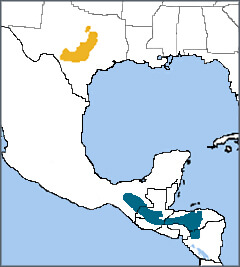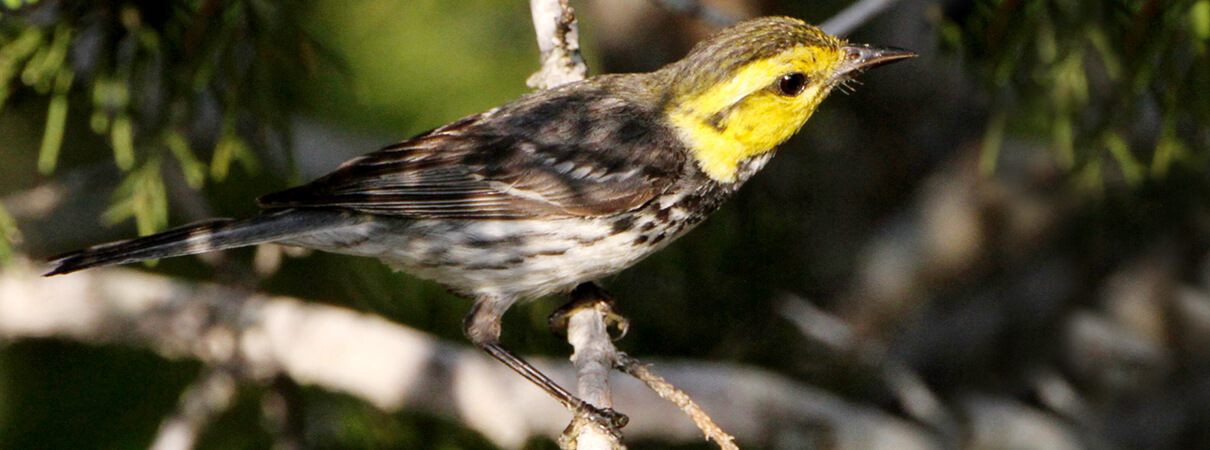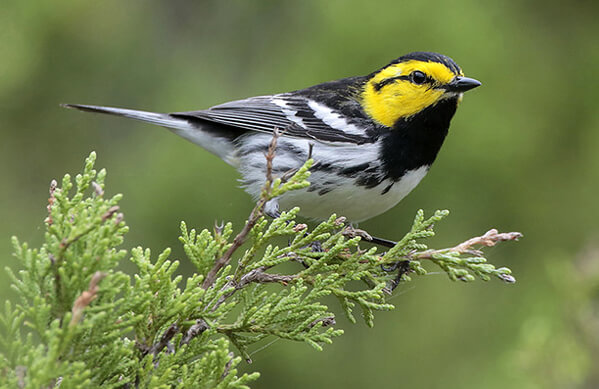 The distinctive Golden-cheeked Warbler, also known as the “Gold Finch of Texas,” is a specialty of that state, nesting nowhere else in the world. It shares its breeding areas in the Edwards Plateau of central Texas, locally known as the Texas Hill Country, with another federally endangered species, the Black-capped Vireo.
The distinctive Golden-cheeked Warbler, also known as the “Gold Finch of Texas,” is a specialty of that state, nesting nowhere else in the world. It shares its breeding areas in the Edwards Plateau of central Texas, locally known as the Texas Hill Country, with another federally endangered species, the Black-capped Vireo.
Like Kirtland's Warbler, Golden-cheeked Warblers are especially vulnerable to human-caused threats because of their already-limited range and small population. Habitat loss and fragmentation and brood parasites such as Brown-headed Cowbirds have driven this species close to extinction.
Unfortunately, the Golden-cheeked Warbler's main breeding areas in Texas are also popular with people, with conversion of habitat to housing developments and agriculture taking an ongoing toll. This warbler's winter habitat in the pine-oak mountain forests of Mexico and northern Central America is also being lost to deforestation for livestock grazing and fuelwood collection.
Sign ABC's Together for Birds petition and help save vital protections for endangered birds!
Feeding on the Fly
Like other North American wood warblers, including Golden-winged, Magnolia, and Prairie, the Golden-cheeked Warbler feeds almost entirely on insects and spiders. Caterpillars are a particularly important prey item during the breeding season; adults “tenderize” the caterpillars by beating them on a branch before eating or feeding to their young.
(You can help warblers and other birds by using native plants in your garden, since native plants support most insect species. For example, native oak trees are a food source for more than 500 kinds of insects that provide food for birds!)
The Golden-cheeked Warbler forages in the upper two-thirds of junipers and deciduous trees, apparently never descending to the ground to feed. Its most common method of feeding is hopping among the branches, gleaning insects from the foliage as it goes. The birds also make short flights to catch insects in mid-air.
Juniper Specialists
Golden-cheeked Warblers arrive on their breeding grounds beginning in early March. The male establishes a breeding territory of three to six acres, often returning to the same site each year. He defends this area with song, chases, and even attacks on intruding males.

Female Golden-cheeked Warbler by Larry Thompson
Extreme habitat specialists, the species requires a combination of mature Ashe juniper and deciduous hardwood trees for successful nesting. An essential element is the juniper trees' shredding bark, which the female needs to build her compact, cup-shaped nest. She may also incorporate spider web, lichens, mosses, leaves, and grass.
The female does most of the incubating of her three to five eggs, but both parents feed the nestlings, even after the young fledge. Parent birds split the brood, with each adult continuing to feed chicks for the next four to seven weeks.
Continuing Challenges
In 1990, the U.S. Fish and Wildlife Service listed Golden-cheeked Warbler as Endangered under the Endangered Species Act (ESA). It is also on the 2016 Partners in Flight Landbird Conservation Plan Red Watch List, which highlights species most in danger of extinction without significant conservation action.
The U.S. Army's Fort Hood provides important habitat for this warbler, and it can also be found in many state parks. Balcones Canyonlands National Wildlife Refuge was created specifically to conserve the warbler and the Black-capped Vireo; the park also implements a cowbird trapping program and hosts an annual Songbird Festival.
Golden-cheeked Warbler populations have recovered to some extent, but habitat loss remains a major threat. Although various groups have petitioned the Department of the Interior to remove the warbler from the Endangered Species Act, the U.S. Fish and Wildlife Service has declined to do so, most recently in June 2016, citing continuing habitat destruction, fragmentation and degradation in central Texas.
Read more about the successes of the ESA and why it is still so important to birds like the Golden-cheeked Warbler.
Donate to support ABC's conservation mission!



















































